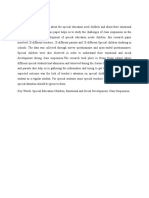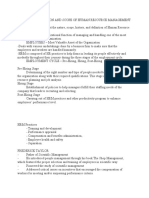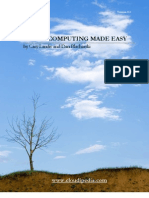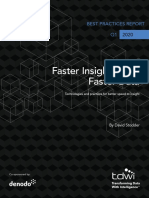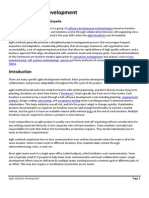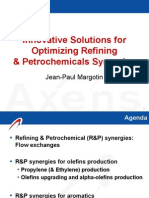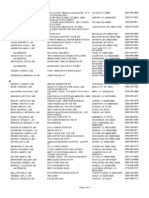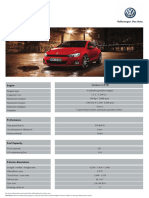SPPM Notes 1
SPPM Notes 1
Uploaded by
kokiladevirajaveluCopyright:
Available Formats
SPPM Notes 1
SPPM Notes 1
Uploaded by
kokiladevirajaveluOriginal Description:
Original Title
Copyright
Available Formats
Share this document
Did you find this document useful?
Is this content inappropriate?
Copyright:
Available Formats
SPPM Notes 1
SPPM Notes 1
Uploaded by
kokiladevirajaveluCopyright:
Available Formats
KARPAGA VINAYAGA COLLEGE OF ENGINEERING AND TECHNOLOGY
Department of CSE
UNIT I
SOFTWARE PROJECT AND PROCESS MANAGEMENT
INTRODUCTION
SOFTWARE:
Software is a set of instruction used to perform a specific task.
ENGINEERING:
It comprises analysis,design,construction,verification and management of technical
entities.
SOFTWARE ENGINEERING:
IEEE: International Electrical and Electronic Engineer
It is a systematic,disciplined,quantifiable approach for the development,operation,maintenance of
software.
SOFTWARE ENGINEERING PARADIGM:
A combination of software engineering layers and generic view of software engineering is
called Software Engineering Paradigm.
SOFTWARE ENGINEERING LAYERS:
Tools
Methods
Process
Quality
SOFTWARE VIEW OF SOFTWARE ENGINEERING:
1.Analysis
2.Design
3.Implementation
4.Testing
5.Maintenance
SOFTWARE PROCESS MODELS:
Waterfall life cycle model
RAD model
Prototype model
Spiral model
Incremental model
Object oriented model
Winwin spiral model
S/W Engineering Paradigm
The term "software engineering" was coined in about 1969 to mean "the establishment and
use of sound engineering principles in order to economically obtain software that is reliable and works
efficiently on real machines".
This view opposed uniqueness and "magic" of programming in an effort to move the
development of software from "magic" (which only a select few can do) to "art" (which the
talented can do) to "science" (which supposedly anyone can do!). There have been numerous
definitions given for software engineering (including that above and below).
Software Engineering is not a discipline; it is an aspiration, as yet unachieved. Many
approaches have been proposed including reusable components, formal methods, structured methods
and architectural studies. These approaches chiefly emphasize the engineering product; the solution
rather than the problem it solves.
Software Development current situation:
People developing systems were consistently wrong in their estimates of time, effort, and costs
Reliability and maintainability were difficult to achieve
Delivered systems frequently did not work
1979 study of a small number of government projects showed that:
2% worked
3% could work after some corrections
45% delivered but never successfully used
20% used but extensively reworked or abandoned
30% paid and undelivered
Fixing bugs in delivered software produced more bugs
Increase in size of software systems
NASA
StarWars Defense Initiative
Social Security Administration
financial transaction systems
Changes in the ratio of hardware to software costs
early 60's - 80% hardware costs
middle 60's - 40-50% software costs
today - less than 20% hardware costs
Increasingly important role of maintenance
Fixing errors, modification, adding options
Cost is often twice that of developing the software
Advances in hardware (lower costs)
Advances in software techniques (e.g., users interaction)
Increased demands for software
Medicine, Manufacturing, Entertainment, Publishing
Demand for larger and more complex software systems
Airplanes (crashes), NASA (aborted space shuttle launches),
"ghost" trains, runaway missiles,
ATM machines (have you had your card "swallowed"?), life-support systems, car
systems, etc.
US National security and day-to-day operations are highly dependent on computerized
systems.
Manufacturing software can be characterized by a series of steps ranging from concept exploration to
final retirement; this series of steps is generally referred to as a software lifecycle.
Steps or phases in a software lifecycle fall generally into these categories:
Requirements (Relative Cost 2%)
Specification (analysis) (Relative Cost 5%)
Design (Relative Cost 6%)
Implementation (Relative Cost 5%)
Testing (Relative Cost 7%)
Integration (Relative Cost 8%)
Maintenance (Relative Cost 67%)
Retirement
Software engineering employs a variety of methods, tools, and paradigms.
Paradigms refer to particular approaches or philosophies for designing, building and maintaining
software. Different paradigms each have their own advantages and disadvantages which make one
more appropriate in a given situation than perhaps another (!).
A method (also referred to as a technique) is heavily depended on a selected paradigm and may be
seen as a procedure for producing some result. Methods generally involve some formal notation and
process(es).
Tools are automated systems implementing a particular method.
Thus, the following phases are heavily affected by selected software paradigms
Design
Implementation
Integration
Maintenance
The software development cycle involves the activities in the production of a software system.
Generally the software development cycle can be divided into the following phases:
Requirements analysis and specification
Design
Preliminary design
Detailed design
Implementation
Component Implementation
Component Integration
System Documenting
Testing
Unit testing
Integration testing
System testing
Installation and Acceptance Testing
Maintenance
Bug Reporting and Fixing
Change requirements and software upgrading
Software lifecycles that will be briefly reviewed include:
Build and Fix model
Waterfall and Modified Waterfall models
Rapid Prototyping
Boehm's spiral model
VERIFICATION VS VALIDATION
Verification:
"Are we building the product right"
The software should conform to its specification
Validation:
"Are we building the right product"
The software should do what the user really requires
Is a whole life-cycle process - V & V must be
applied at each stage in the software process.
Has two principal objectives
o The discovery of defects in a system
o The assessment of whether or not the system is usable in an
operational situation.
Static and dynamic verification
Software inspections Concerned with analysis of
the static system representation to discover problems (static verification)
o May be supplement by tool-based document and code analysis
Software testing Concerned with exercising and
observing product behaviour (dynamic verification)
o The system is executed with test data and its operational behaviour is observed
V& V goals
Verification and validation should establish confidence that the software is fit for purpose
This does NOT mean completely free of defects
Rather, it must be good enough for its intended use and the type of use will determine the
degree of confidence that is needed
V & V planning
Careful planning is required to get the most out of testing and inspection processes
Planning should start early in the development process
The plan should identify the balance between static verification and testing
Test planning is about defining standards for the testing process rather than describing
product tests
The V-model of development
Software validation
o Verification and validation (V & V) is intended to show that a system conforms to its
specification and meets the requirements of the system customer.
o Involves checking and review processes and system testing.
o System testing involves executing the system with test cases that are derived from the
specification of the real data to be processed by the system.
Life Cycle models
o The waterfall model
Separate and distinct phases of specification and development.
o Evolutionary development
Specification, development and validation are interleaved.
o Component-based software engineering
The system is assembled from existing components.
o There are many variants of these models e.g. formal development where a waterfall-
like process is used but the specification is a formal specification that is refined
through several stages to an implementable design.
Waterfall model phases
Requirements analysis and definition
System and software design
Implementation and unit testing
Integration and system testing
Operation and maintenance
The main drawback of the waterfall model is the difficulty of accommodating
change after the process is underway. One phase has to be complete before
moving onto the next phase.
Waterfall model
Waterfall model problems
o Inflexible partitioning of the project into distinct stages makes it difficult to
respond to changing customer requirements.
o Therefore, this model is only appropriate when the requirements are well-
understood and changes will be fairly limited during the design process.
o Few business systems have stable requirements.
o The waterfall model is mostly used for large systems engineering projects where a
system is developed at several sites.
Evolutionary development
o Exploratory development
Objective is to work with customers and to evolve a final system from an
initial outline specification. Should start with well-understood requirements
and add new features as proposed by the customer.
o Throw-away prototyping
Objective is to understand the system requirements. Should start with
poorly understood requirements to clarify what is really needed.
Evolutionary development
Evolutionary development
o Problems
Lack of process visibility;
Systems are often poorly structured;
Special skills (e.g. in languages for rapid prototyping) may be required.
o Applicability
For small or medium-size interactive systems;
For parts of large systems (e.g. the user interface);
For short-lifetime systems.
Incremental development
Incremental development advantages
Customer value can be delivered with each increment so system functionality is
available earlier.
Early increments act as a prototype to help elicit requirements for later
increments.
Lower risk of overall project failure.
The highest priority system services tend to receive the most testing.
Spiral development
Process is represented as a spiral rather than as a sequence of activities with
backtracking.
Each loop in the spiral represents a phase in the process.
No fixed phases such as specification or design - loops in the spiral are chosen
depending on what is required.
Risks are explicitly assessed and resolved throughout the process.
Spiral model of the software process
RAD MODEL:
Business Business
Modeling Modeling
Data Data
Modeling Modeling
Process Process
Modeling Modeling
Application Application
Generation Generation
Testing & Testing &
Turnover Turnover
60 90 Days
PROTOTYPE MODEL:
It has 6 steps, They are as follows:
Requirement collection
Quick Design
Prototype creation(or)modification
Assessment
Prototype refinement
LISTEN REUSE / REBUILD
TOWARDS THE MOCK-UP
CUSTOMER
CUSTOMER TEST
DRIVES MOCK - UP
BUSINESS PROCESS ENGINEERING
o Concerned with re-designing business processes to make them more responsive and
more efficient
o Often reliant on the introduction of new computer systems to support the revised
processes
o May force software re-engineering as the legacy systems are designed to support
existing processes
The re-engineering process
Re-engineering approaches
SYSTEM ENGINEERING
What is a system?
o A purposeful collection of inter-related components working together towards
some common objective.
o A system may include software, mechanical, electrical and electronic hardware and
be operated by people.
o System components are dependent on other
system components
o The properties and behaviour of system components are inextricably inter-
mingled
Problems of systems engineering
o Large systems are usually designed to solve 'wicked' problems Systems
engineering requires a great deal of co-ordination across disciplines
o Almost infinite possibilities for design trade-offs across components
o Mutual distrust and lack of understanding across engineering disciplines
o Systems must be designed to last many years in a changing environment
Software and systems engineering
The proportion of software in systems is increasing. Software-driven general
purpose electronics is replacing special-purpose systems
Problems of systems engineering are similar to problems of software engineering
Software is (unfortunately) seen as a problem in systems engineering. Many large
system projects have been delayed because of software problems
The system engineering process
o Usually follows a waterfall model because of the need for parallel development of
different parts of the system
Little scope for iteration between phases because hardware changes are very
expensive. Software may have to compensate for hardware problems
o Inevitably involves engineers from different disciplines who must work together
Much scope for misunderstanding here. Different disciplines use a
different vocabulary and much negotiation is required. Engineers may
have personal agendas to fulfil.
The systems engineering process
COMPUTER-BASED SYSTEMS
Definition
A set or arrangement of elements that are organized to accomplish some predefined goal by
processing information.
The goal may be to support some business function or to develop a product that can be sold
to generate business revenue. To accomplish the goal, a computer-based systemmakes use of a
variety of system elements:
Software. Computer programs, data structures, and related documentation that serve to effect
the logical method, procedure, or control that is required.
Hardware. Electronic devices that provide computing capability, the interconnectivity
devices (e.g., network switches, telecommunications devices) that enable the flow ofdata,
and electromechanical devices (e.g., sensors, motors, pumps) that provide external world
function.
People.Users and operators of hardware and software.
Database.A large, organized collection of information that is accessed via
software.Documentation.Descriptive information (e.g., hardcopy manuals, on-line help files,
Web sites) that portrays the use and/or operation of the system.
Procedures.The steps that define the specific use of each system element or theprocedural
context in which the system resides.
The elements combine in a variety of ways to transform information. For example, a marketing
department transforms raw sales data into a profile of the typical purchaser of a product; a robot
transforms a command file containing specific instructions into a set of control signals that cause some
specific physical action. Creating an information system to assist the marketing department and control
software to support the robot both require system engineering.
Product Engineering Overview
Product Engineering
Product engineering is a crucial term in the sphere of software development. It is through product
engineering that the future of a product is decided. The purpose of software Product Engineering is to
consistently and innovatively perform a well-defined engineering process that integrates all software
engineering activities to effectively and efficiently develop correct, consistent software products.
Software Engineering tasks include analyzing the system requirements allocated to software, developing
software architecture, designing the software, implementing the software in the code, integrating
software components, and testing the software to verify whether it specifies specific requirements.
Product Conceptualization Engineering
o Write product marketing/business requirements specifications (MRS, BRS, PRD),
system requirements specifications and functional specifications (SRS, FS)
oIdentify and design key
featuresoSelect architecture and
design o Provide UI prototypes
Product Architecture Consulting
o Construct the technology foundations needed to build robust products
o Consult on Enterprise Application Integration, Distributed Computing, Transaction
Management
o Select architectural styles and patterns
Product Design and Implementation
Draw a development strategy
Integrate and customize products to meet requirements
Train the end-user on product skills
Reinforcing product best practices
Testing for any technical issue
You might also like
- Nema Receptacles Wiring DiagramDocument5 pagesNema Receptacles Wiring DiagramBryan Llena100% (1)
- Risk Assessment Techniques For Software DevelopmentDocument8 pagesRisk Assessment Techniques For Software DevelopmentJayaletchumi MoorthyNo ratings yet
- Cp7301 Software Process and Project Management Notes PDFDocument153 pagesCp7301 Software Process and Project Management Notes PDFAakashNo ratings yet
- 52788-L330 Lantec Winch Carrier WinchDocument52 pages52788-L330 Lantec Winch Carrier WinchDaniel Rincón100% (3)
- Bachelor in Business Administration School: Business Administration SemesterDocument15 pagesBachelor in Business Administration School: Business Administration SemesterBrute1989No ratings yet
- Oracle WebLogic ServerDocument7 pagesOracle WebLogic ServerEmadNo ratings yet
- Cloud e BookDocument10 pagesCloud e Bookmram_maddaliNo ratings yet
- BCA 2nd YearDocument31 pagesBCA 2nd YearAnas BaigNo ratings yet
- Role of Business Intelligence in Business Performance Management.Document6 pagesRole of Business Intelligence in Business Performance Management.Ashar Sultan KayaniNo ratings yet
- Improving The Software SystemDocument20 pagesImproving The Software SystemwkkchamaraNo ratings yet
- Letter of Transmittal: (Author Name) 1Document52 pagesLetter of Transmittal: (Author Name) 1jisansalehin1No ratings yet
- CS706 Lecture Handouts PDF FormatDocument220 pagesCS706 Lecture Handouts PDF FormatNazish NaeemNo ratings yet
- Enterprise Resource Planing - ERPDocument14 pagesEnterprise Resource Planing - ERPArif MasoodNo ratings yet
- Notes On MISDocument17 pagesNotes On MISvarsha rathoreNo ratings yet
- Human Resource Management Course OutlineDocument22 pagesHuman Resource Management Course OutlinedalalbotaNo ratings yet
- Luftman Chapter 2 Part 1Document25 pagesLuftman Chapter 2 Part 1Lazaro X MedinaNo ratings yet
- Production Management Set1 and Set2Document40 pagesProduction Management Set1 and Set2Shiva PrakashNo ratings yet
- Cloud Computing Made EasyDocument67 pagesCloud Computing Made EasyTanmay BhardwajNo ratings yet
- Enterprise System Lecture02Document12 pagesEnterprise System Lecture02Faryal AftabNo ratings yet
- Bahria University: Assignment # 1Document9 pagesBahria University: Assignment # 1AqsaGulzarNo ratings yet
- Unit 1Document14 pagesUnit 1Nikhil GajendraNo ratings yet
- Intl MKG BSC NotesDocument65 pagesIntl MKG BSC NotesNgang PerezNo ratings yet
- BusinessAnalystChecklists V1Document35 pagesBusinessAnalystChecklists V1krishnandhanapalNo ratings yet
- Project Manager101 Guide For Automation - Paper PDFDocument16 pagesProject Manager101 Guide For Automation - Paper PDFKleberson MeirelesNo ratings yet
- Enterprise Resource PlanningDocument5 pagesEnterprise Resource PlanningNishanth JohnsonNo ratings yet
- MIS Unit 2Document20 pagesMIS Unit 2Shashank GirepunjeNo ratings yet
- Pom 76 PageDocument76 pagesPom 76 PageDươngNo ratings yet
- Diploma in Logistic & Supply (Cargo Management)Document10 pagesDiploma in Logistic & Supply (Cargo Management)Pallav singhNo ratings yet
- Cloud Computing World Issue 3 - December 2014 PDFDocument46 pagesCloud Computing World Issue 3 - December 2014 PDFwulandariweniNo ratings yet
- Production and Total Quality ManagementDocument17 pagesProduction and Total Quality ManagementFalguni MathewsNo ratings yet
- Cloud Solutions Reference Data Management 0514 1Document16 pagesCloud Solutions Reference Data Management 0514 1subash pradhanNo ratings yet
- Cloud Computing and Business Intelligence by Alexandru TOLEDocument10 pagesCloud Computing and Business Intelligence by Alexandru TOLERafaelNo ratings yet
- Project Management From Azeem SirDocument77 pagesProject Management From Azeem SirOoAIDoONo ratings yet
- Traa, J.W.A. - RUP vs. MSF - A Comparative StudyDocument140 pagesTraa, J.W.A. - RUP vs. MSF - A Comparative Studyapi-3776312100% (1)
- Data Warehousing & Data Mining Syllabus Subject Code:56055 L:4 T/P/D:0 Credits:4 Int. Marks:25 Ext. Marks:75 Total Marks:100Document52 pagesData Warehousing & Data Mining Syllabus Subject Code:56055 L:4 T/P/D:0 Credits:4 Int. Marks:25 Ext. Marks:75 Total Marks:100hanmanthNo ratings yet
- Data Warehousing Keys To Success WP UsDocument16 pagesData Warehousing Keys To Success WP UssatheeshbabunNo ratings yet
- Blockchain in Logistics and Supply Chain: A Lean Approach For Designing Real-World Use CasesDocument11 pagesBlockchain in Logistics and Supply Chain: A Lean Approach For Designing Real-World Use CasesTalha ImtiazNo ratings yet
- Digital Notes ON Software Process and Project Management (R17A0539)Document94 pagesDigital Notes ON Software Process and Project Management (R17A0539)Varun reddyNo ratings yet
- CRM - Notes by SudarshanDocument45 pagesCRM - Notes by Sudarshanapi-26355935100% (4)
- Smart Gym Management SystemDocument17 pagesSmart Gym Management SystemMasha KingNo ratings yet
- Test 03Document96 pagesTest 03peter hany100% (1)
- Quantitative ApproachDocument18 pagesQuantitative ApproachSana Rafique0% (1)
- A Study On The Impact of Social Media Marketing Trends On Digital MarketingDocument6 pagesA Study On The Impact of Social Media Marketing Trends On Digital MarketingJohn Ryan Maglente AnsitNo ratings yet
- Unit 1 Fundamental of E-Commerce (Bba-606) - CompleteDocument56 pagesUnit 1 Fundamental of E-Commerce (Bba-606) - CompleteGaurav VikalNo ratings yet
- Analysis of Consumer Engagement For Gateway Software Solutions For Preferred Online Classifieds PlatformDocument55 pagesAnalysis of Consumer Engagement For Gateway Software Solutions For Preferred Online Classifieds PlatformRakesh RakiNo ratings yet
- Decision Making and Role of MisDocument21 pagesDecision Making and Role of Mismanisha2ndjanNo ratings yet
- Warehouse CompleteDocument6 pagesWarehouse CompletegurugabruNo ratings yet
- Datagovernancematuritymodel Thesis Janrutgermerkus Nov2015Document75 pagesDatagovernancematuritymodel Thesis Janrutgermerkus Nov2015Heru NugrohoNo ratings yet
- 1 Virtualization Technology Literature ReviewDocument7 pages1 Virtualization Technology Literature ReviewJohn FranklinNo ratings yet
- Lecture 4 (Enterprise Systems)Document31 pagesLecture 4 (Enterprise Systems)Jia AhmedNo ratings yet
- DFD Sistem e BankingDocument11 pagesDFD Sistem e BankingArif Budiman100% (1)
- Faster Insights From Faster Data: Best Practices Report Q1Document38 pagesFaster Insights From Faster Data: Best Practices Report Q1drewen deeeNo ratings yet
- Strategic Information Systems Planning - Answers To Study QuestionsDocument19 pagesStrategic Information Systems Planning - Answers To Study QuestionsOyedele AjagbeNo ratings yet
- Loan Management SystemDocument71 pagesLoan Management SystemaddagallamahendraNo ratings yet
- Unit 1Document42 pagesUnit 1Geba RibaNo ratings yet
- Thesis of Inventory Control With InflationDocument20 pagesThesis of Inventory Control With Inflationgarvitasingh100% (1)
- Agile SDLC (Wiki)Document12 pagesAgile SDLC (Wiki)ghar_dashNo ratings yet
- The Future of Work: Adapting to the Rise of Automation and AIFrom EverandThe Future of Work: Adapting to the Rise of Automation and AINo ratings yet
- Business Process Automation Tools A Complete Guide - 2020 EditionFrom EverandBusiness Process Automation Tools A Complete Guide - 2020 EditionNo ratings yet
- 2 - Jean PaulDocument27 pages2 - Jean PaulnandosmarquezNo ratings yet
- Group 37A: General Description. - . - . - . - . Power Steering Diagnosis - .Document50 pagesGroup 37A: General Description. - . - . - . - . Power Steering Diagnosis - .dudurezNo ratings yet
- Maintenance Manual: Fan Jet FalconDocument15 pagesMaintenance Manual: Fan Jet FalconFederico KronenbergNo ratings yet
- PDU For TMA Catalog (Add 3DT) - Add CEQ V3.0 - 001 PDFDocument3 pagesPDU For TMA Catalog (Add 3DT) - Add CEQ V3.0 - 001 PDFpandavision76No ratings yet
- Info Iec62380 (Ed1.0) enDocument9 pagesInfo Iec62380 (Ed1.0) enaryanmdNo ratings yet
- US8069593Document9 pagesUS8069593PUVAN TSTNo ratings yet
- 5800 Data SheetDocument2 pages5800 Data Sheetdummy_office50% (2)
- All Chapter Download Fundamentals of Cognitive Psychology 3rd Edition Kellogg Test BankDocument41 pagesAll Chapter Download Fundamentals of Cognitive Psychology 3rd Edition Kellogg Test Bankfrljakbnce100% (2)
- Isol Job Reference 2008-2017 PDFDocument9 pagesIsol Job Reference 2008-2017 PDFAbu Zafeera Saqib SipahiNo ratings yet
- Determining The Water Holding Capacity of Microbial CelluloseDocument4 pagesDetermining The Water Holding Capacity of Microbial CellulosegoldennanukNo ratings yet
- 5X2X3 - JapfaMedanDocument1 page5X2X3 - JapfaMedanGrab StrongNo ratings yet
- Blaby Hertigate Walk Route 12Document2 pagesBlaby Hertigate Walk Route 12Laura Diaz MontesNo ratings yet
- Ottawa Truck Parts For Sale Buckeye Western StarDocument60 pagesOttawa Truck Parts For Sale Buckeye Western StarOmkar TerkhedkarNo ratings yet
- Din 319Document3 pagesDin 319Horváth VivienNo ratings yet
- Fire Safety Evaluation at WorkplaceDocument41 pagesFire Safety Evaluation at WorkplaceAz RiefNo ratings yet
- 360 Ripples Solutions: Key Achievements Our PlacementsDocument1 page360 Ripples Solutions: Key Achievements Our PlacementsSATHEESKUMAR NATARAJANNo ratings yet
- Problem Chapter 3Document3 pagesProblem Chapter 3Ventri Galuh DikaraNo ratings yet
- Balance Score Card and Just in TimeDocument23 pagesBalance Score Card and Just in TimePoojaVartakNo ratings yet
- Rra Heat Treatment of Al 7075-T6Document12 pagesRra Heat Treatment of Al 7075-T6Arissa Lidia Eva AdventiaNo ratings yet
- Rainbow FormationDocument6 pagesRainbow FormationMystical ProductionsNo ratings yet
- Anm Part 1Document11 pagesAnm Part 1aptureincNo ratings yet
- Mezcladores Estaticos Sulzer en RefineriasDocument46 pagesMezcladores Estaticos Sulzer en Refineriasconcivasa100% (1)
- 4 T 533Document3 pages4 T 533ogsenzowanNo ratings yet
- Pressure Vessel Design ProjectDocument29 pagesPressure Vessel Design Projectbekalu50% (2)
- Op Eff 16 12 2023Document45 pagesOp Eff 16 12 2023Sharath BogaNo ratings yet
- VW SCDocument2 pagesVW SCkoreswilsonNo ratings yet
- Isle Ro 2015Document12 pagesIsle Ro 2015nagy_andor_csongorNo ratings yet
- ELSSG04Document18 pagesELSSG04Ariel Anibal AparicioNo ratings yet









